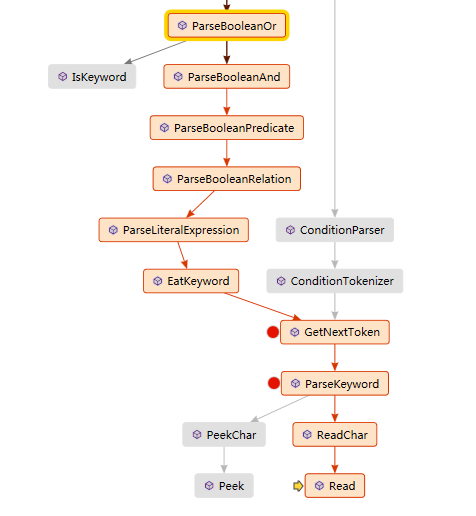NLog详解(五) - Condition Expression
Sample
<!-- during normal execution only log Info messages --> <defaultFilter>level >= LogLevel.Info</defaultFilter> <!-- if there is at least one error, log everything from trace level --> <when exists="level >= LogLevel.Error" filter="level >= LogLevel.Trace" />实现将字符串转换成表达式进行逻辑判断,然后做出相应的动作。这个过程的实现使用Condition Expression。
从简单的例子开始:
public void BooleanOperatorTest() { AssertEvaluationResult(false, "false or false"); AssertEvaluationResult(true, "false or true"); AssertEvaluationResult(true, "true or false"); AssertEvaluationResult(true, "true or true"); AssertEvaluationResult(false, "false and false"); AssertEvaluationResult(false, "false and true"); AssertEvaluationResult(false, "true and false"); AssertEvaluationResult(true, "true and true"); AssertEvaluationResult(false, "not true"); AssertEvaluationResult(true, "not false"); AssertEvaluationResult(false, "not not false"); AssertEvaluationResult(true, "not not true"); } 输入的是字符串 false or false ,我们希望的结果是得到 false ,大概的过程是这样的:

CondtionParser
/// <summary> /// Condition parser. Turns a string representation of condition expression /// into an expression tree. /// </summary> public class ConditionParser第一步就是初始化这个Parser
var parser = new ConditionParser(new SimpleStringReader(expressionText), configurationItemFactories);顺带初始化了tokenizer
private ConditionParser(SimpleStringReader stringReader, ConfigurationItemFactory configurationItemFactory) { this.configurationItemFactory = configurationItemFactory; this.tokenizer = new ConditionTokenizer(stringReader); } 构造函数里直接取到了第一个token false
public ConditionTokenizer(SimpleStringReader stringReader) { this.stringReader = stringReader; this.TokenType = ConditionTokenType.BeginningOfInput; this.GetNextToken(); } 获取的过程也比较的简单,一个接一个的读入 char, 遇到非指定的字符即停止
private void ParseKeyword(char ch) { int i; this.TokenType = ConditionTokenType.Keyword; StringBuilder sb = new StringBuilder(); sb.Append((char)ch); this.ReadChar(); while ((i = this.PeekChar()) != -1) { if ((char)i == '_' || (char)i == '-' || char.IsLetterOrDigit((char)i)) { sb.Append((char)this.ReadChar()); } else { break; } } this.TokenValue = sb.ToString(); } 这里有一系列比较复杂的表达式树生成的过程:
private ConditionExpression ParseBooleanOr() { ConditionExpression expression = this.ParseBooleanAnd(); while (this.tokenizer.IsKeyword("or") || this.tokenizer.IsToken(ConditionTokenType.Or)) { this.tokenizer.GetNextToken(); expression = new ConditionOrExpression(expression, this.ParseBooleanAnd()); } return expression; } 最后拿到的表达式树是这样的:

左右的表达式为 ConditionLiteralExpression 。
private ConditionExpression ParseLiteralExpression() { //...... if (this.tokenizer.TokenType == ConditionTokenType.Keyword) { string keyword = this.tokenizer.EatKeyword(); if (0 == string.Compare(keyword, "level", StringComparison.OrdinalIgnoreCase)) { return new ConditionLevelExpression(); } if (0 == string.Compare(keyword, "logger", StringComparison.OrdinalIgnoreCase)) { return new ConditionLoggerNameExpression(); } if (0 == string.Compare(keyword, "message", StringComparison.OrdinalIgnoreCase)) { return new ConditionMessageExpression(); } if (0 == string.Compare(keyword, "loglevel", StringComparison.OrdinalIgnoreCase)) { this.tokenizer.Expect(ConditionTokenType.Dot); return new ConditionLiteralExpression(LogLevel.FromString(this.tokenizer.EatKeyword())); } if (0 == string.Compare(keyword, "true", StringComparison.OrdinalIgnoreCase)) { return new ConditionLiteralExpression(true); } 再来个例子:
public void ConditionMethodsTest() { AssertEvaluationResult(true, "starts-with('foobar','foo')"); AssertEvaluationResult(false, "starts-with('foobar','bar')"); AssertEvaluationResult(true, "ends-with('foobar','bar')"); AssertEvaluationResult(false, "ends-with('foobar','foo')"); AssertEvaluationResult(0, "length('')"); AssertEvaluationResult(4, "length('${level}')"); AssertEvaluationResult(false, "equals(1, 2)"); AssertEvaluationResult(true, "equals(3.14, 3.14)"); AssertEvaluationResult(true, "contains('foobar','ooba')"); AssertEvaluationResult(false, "contains('foobar','oobe')"); AssertEvaluationResult(false, "contains('','foo')"); AssertEvaluationResult(true, "contains('foo','')"); } 这里出现了一些条件方法 starts-with , ends-with , equals , contains ,可以通过这些操作,当log的message包含特定的字符串的时候才写日志

[ConditionMethod("starts-with")] 是以属性反射的方式在初始化的时候加载的。
在parse的过程中,多一步判断是否是ConditionMethods并创建实例
private ConditionMethodExpression ParsePredicate(string functionName) { try { var methodInfo = this.configurationItemFactory.ConditionMethods.CreateInstance(functionName); return new ConditionMethodExpression(functionName, methodInfo, par); } catch (Exception exception) { if (exception.MustBeRethrown()) { throw; } throw new ConditionParseException("Cannot resolve function '" + functionName + "'", exception); } } 那么怎么知道该字符串是否是ConditionMethods呢?这里还是简单从左到右一个个的吃字符。
public string EatKeyword() { if (this.TokenType != ConditionTokenType.Keyword) { throw new ConditionParseException("Identifier expected"); } string s = (string)this.TokenValue; this.GetNextToken(); return s; } 当出现特殊的char时候做出判断。
private static ConditionTokenType[] BuildCharIndexToTokenType() { CharToTokenType[] charToTokenType = { new CharToTokenType('(', ConditionTokenType.LeftParen), new CharToTokenType(')', ConditionTokenType.RightParen), new CharToTokenType('.', ConditionTokenType.Dot), new CharToTokenType(',', ConditionTokenType.Comma), new CharToTokenType('!', ConditionTokenType.Not), new CharToTokenType('-', ConditionTokenType.Minus), }; 正文到此结束
热门推荐
相关文章
Loading...











![[HBLOG]公众号](https://www.liuhaihua.cn/img/qrcode_gzh.jpg)

